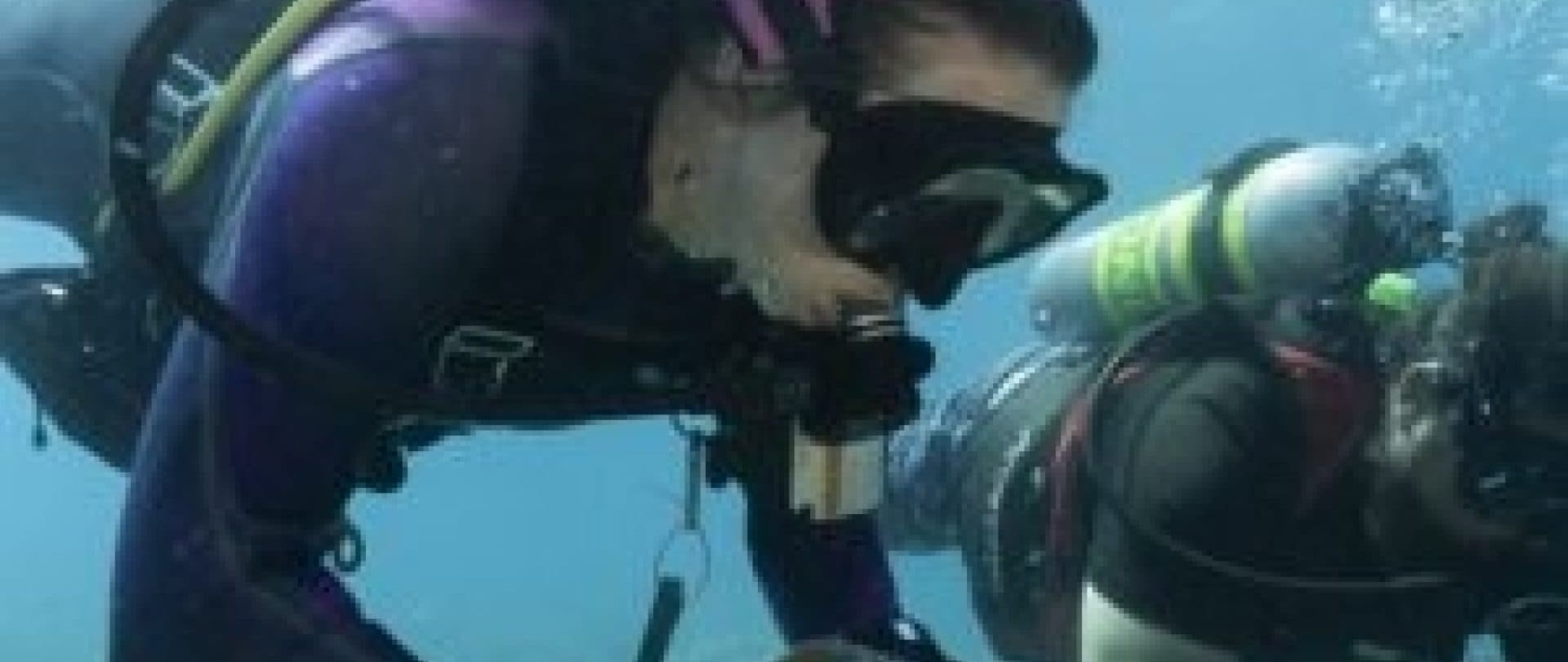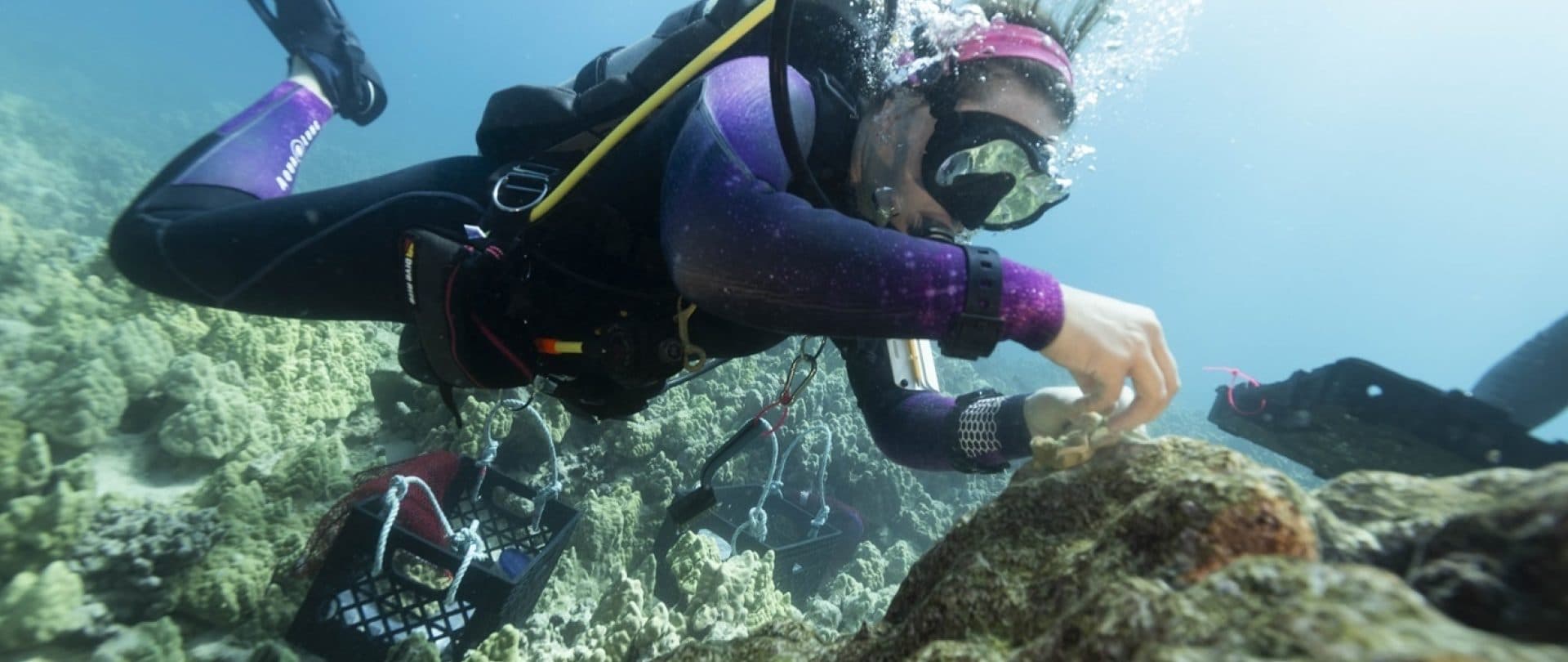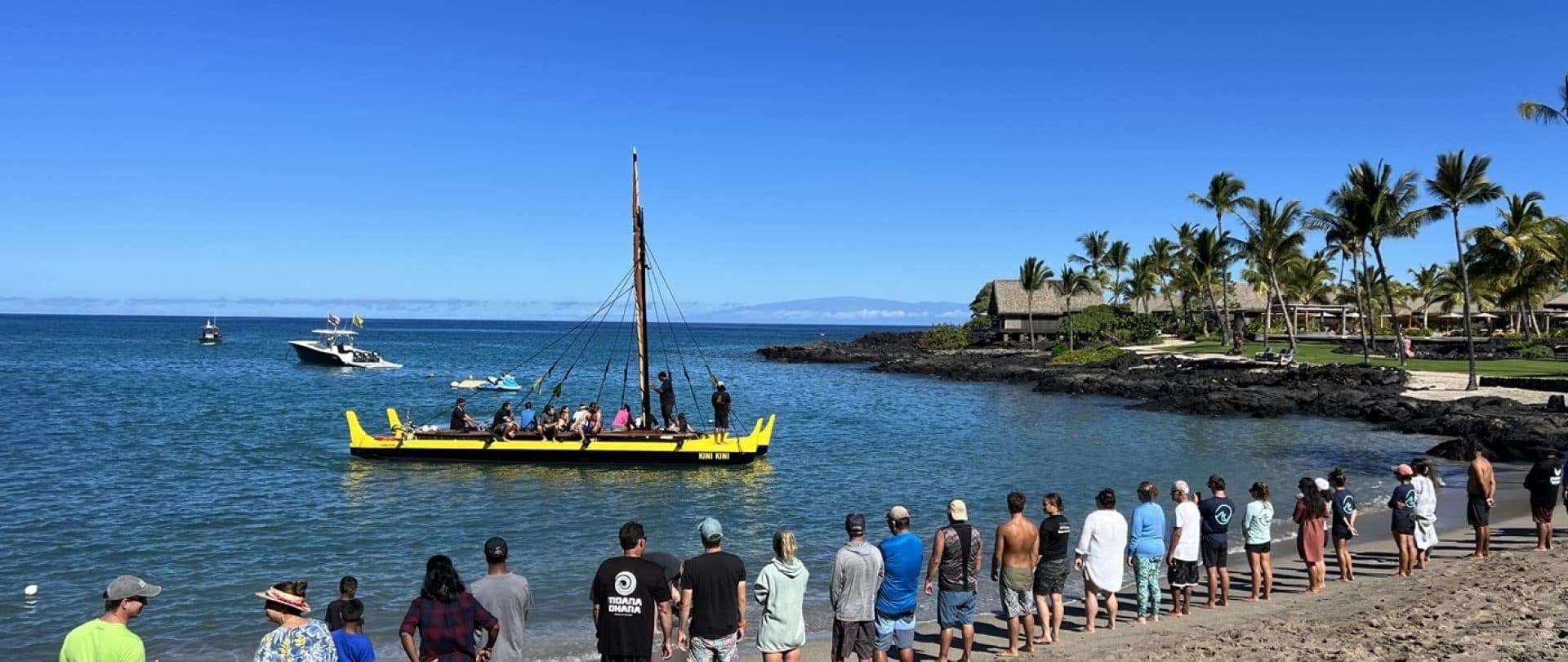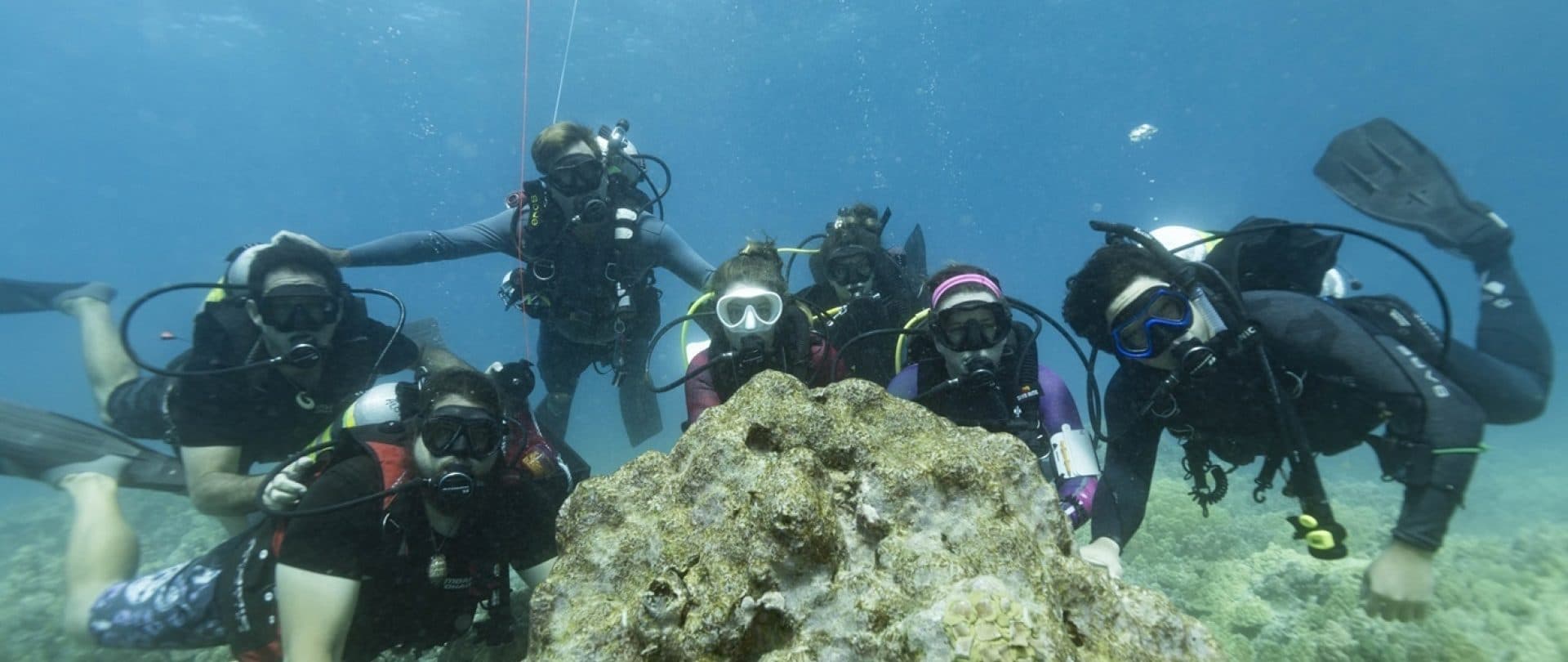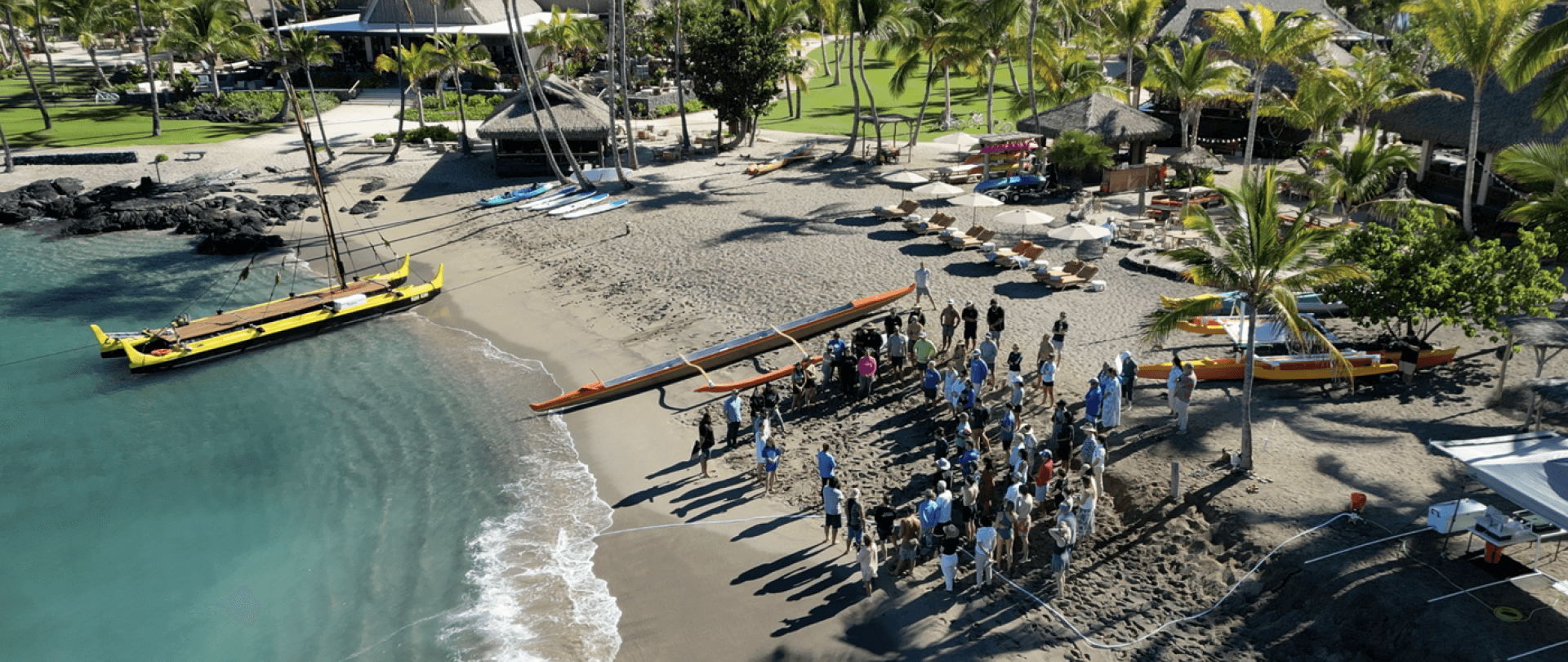Reef Revival
Seizing corals of opportunity
BY Sara Stover
If you hear the sound of a conch shell echoing across the gentle waters of Kahuwai Bay on the Kona Coast, it might signify the members of the Ka‘ūpūlehu Marine Life Advisory Committee (KMLAC) and scuba divers with The Nature Conservancy (TNC) are gathering on the golden sands for a Kanu Ko‘a Coral Restoration event, much like the one that unfolded in late October 2023.
To prepare, as well as honor kūpuna and recognize place, the inaugural Kanu Ko‘a (Planting Corals) event began with kani ka pū (blowing the conch) and oli (chant). After the opening ceremony and protocol, divers and Native Hawaiian lineal descendants of Ka‘ūpūlehu boarded the double-hull canoe, wa‘a Kinikini, and set sail for nearshore coral reefs. Divers descended to the reefs to collect corals of opportunity from the sandy seafloor. These corals broke off the reef due to boat anchors, strong waves or the hands and feet of snorkelers and divers.
In Kumulipo, the Hawaiian creation chant, ko‘a (the coral polyp), was the first organism to emerge from pō (darkness), and everything else was born from that koʻa. As part of KMLAC’s first coral restoration event, the ko‘a once again emerged from the depths of darkness into the sunlight, carefully lifted to the surface in crates before being submerged in coolers of ocean water.
With the precious koʻa safely aboard, waʻa Kinikini returned to shore. Starting at the shoreline and stretching up the beach, the crates of ko‘a fragments were passed carefully from one volunteer to the next until reaching tables set up with specialized saws. Each ko‘a’s bottom skeleton piece was cut off, leaving the top tissue layer for outplanting.
Despite its rock-like appearance, ko‘a is an animal related to anemones and jellyfish.
Coral reefs are the structures formed from calcium carbonate secreted by hard ko‘a. Although cutting an already fragmented ko‘a on all sides into a smaller shape may seem fruitless, it actually accelerates tissue growth and reef recovery when outplanted. Taking advantage of hard ko‘a’s ability to heal, outplanting is a method that binds fragments to the reef, enabling the pieces to reproduce and grow into mature colonies.
Once fragmented, the trimmed koʻa were placed into coolers on waʻa Kinikini’s hull and transported back to the reefs. There, divers returned the koʻa to the sea, using a special, non-toxic sealant to secure fragments to the reef. Outplanted in an array pattern, the fragments will fuse together and grow by as much as 12 centimeters a year.
Keepers of the sea
Thanks to the ecological management systems designed by Ka'ūpūlehu’s kūpuna, the coastal fishing grounds of the area were once teeming with ko‘a, i‘a (fish), he‘e (octopus), ‘opihi (limpets) and ula (lobster). As modern systems encroached on the traditional management systems, ko‘a reefs began to suffer. Two decades of research beginning in the early 1990s revealed that the Kahuwai Bay area lost over 50 percent of its ko‘a. By 2015, the bay’s ko‘a cover declined by 44 percent, and the abundance of iʻa and other food sources dropped 75 percent in turn.
Today, Hawai‘i’s nearshore reefs and waters support more than 7,000 marine life forms, 25 percent of which are only found here. But climate change, land-based pollutants and overfishing continue to threaten the ko‘a reefs, the marine life they support and ancestral lifeways.
Despite these challenges, KMLAC’s community-based restoration efforts can improve our reefs' and people's health and resilience. In 1995, the committee was established to care for the Kaʻūpūlehu and Kūki‘o shoreline areas’ marine resources. KMLAC now consists of local families with ancestral ties to the area, businesses and advocacy groups and landowners who work to restore fish populations and ko‘a reefs through collaborative management with the State.
“Restoration is an important tool in the fight against reef decline, but its adoption in Hawai‘i and the Pacific is relatively novel,” said Joe Pollock, Ph.D., TNC senior coral reef resilience scientist. “By anchoring this project in science and culture while prioritizing learning and knowledge sharing, we can enhance local reef benefits while disseminating the insights needed to scale up reef restoration throughout Hawai'i and beyond successfully.”
Mālama the reefs
In Hawaiian, ka ‘ulu pūlehu means "the roasted breadfruit." The site of a historic settlement, Ka‘ūpūlehu is currently home to the Four Seasons Resort Hualālai and Kona Village. It’s also a state-approved marine reserve, making it an ideal location for out planting and creating a resilient backup in the face of coral bleaching. Coral bleaching happens when environmental stressors cause ko‘a polyps to expel algae living in their tissues —algae that is necessary for the reef’s health.
While they don’t look alive, healthy ko‘a reefs are a living barrier, protecting the shorelines of Ka‘ūpūlehu and other coastal communities from floods, waves and storms. Kanu Ko‘a is the first step in determining the best methods for restoring these natural ko‘a buffers surrounding Hawai‘i Island.
The KMLAC-TNC team also plans to install an in-water nursery table to grow ko‘a from fragments, monitor the growth rates and health of the planted ko‘a and analyze which method of planting helps ko‘a grow best.
“You’ve got to remember that the reef is living! If we don’t do something to set up reefs to survive in the face of climate change, we will fail future generations. If you really love the ocean, be part of the solution,” said Vern Yamanaka, KMLAC member and TNC Trustee.
Here are a few things you can do to help protect and restore the ko‘a:
- Only wear reef-safe sunscreen.
- Never touch or walk on corals.
- Support sustainable fishing practices.
- Practice safe boating by anchoring in sandy areas away from reefs.
- Support local community efforts by donating to TNC Hawaiʻi.
Learn more about the Ka‘ūpūlehu Marine Life Advisory Committee and opportunities to support coral restoration projects at kaupulehufoundation.org. Learn more about The Nature Center and making a difference in Hawai‘i at nature.org.
